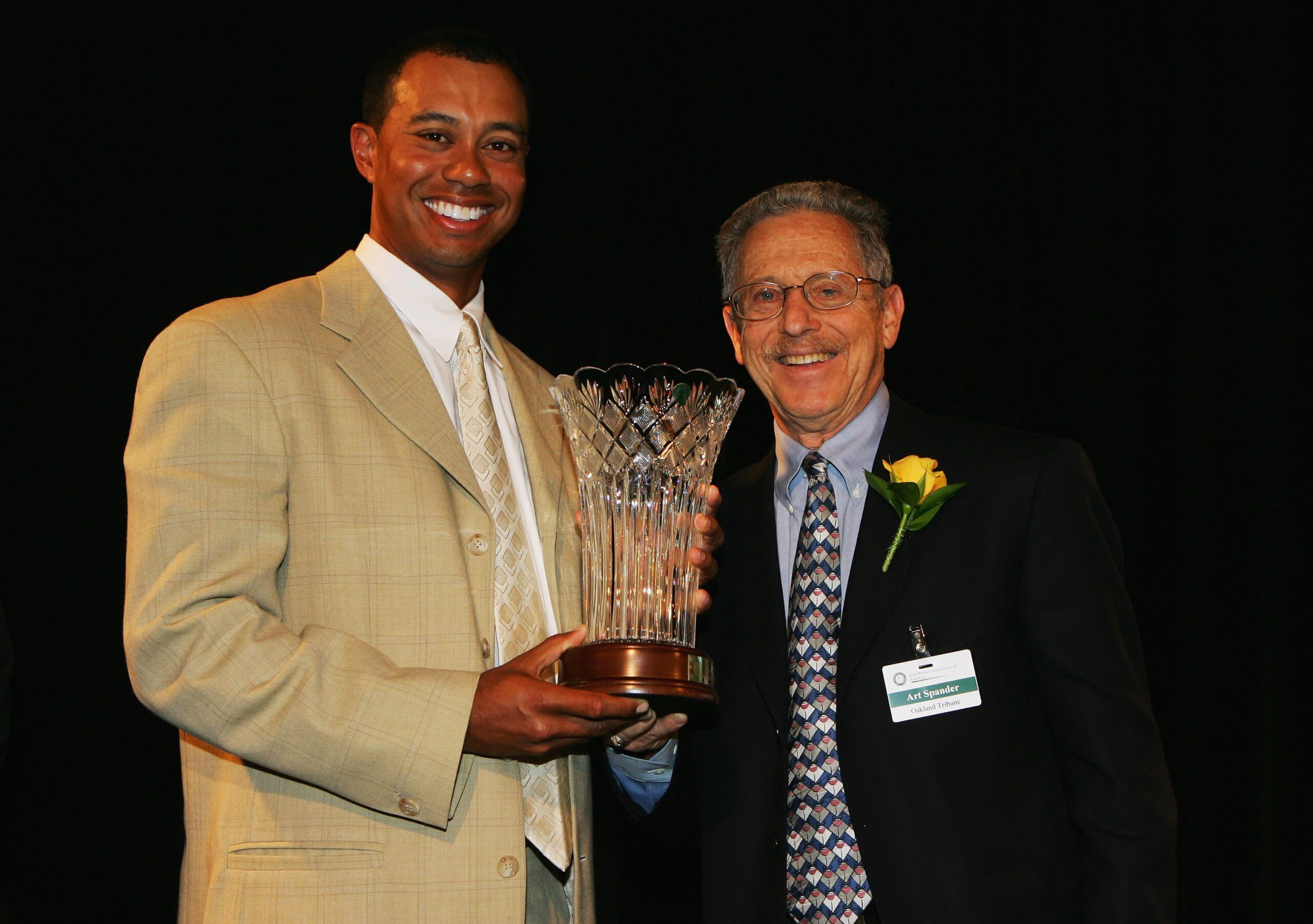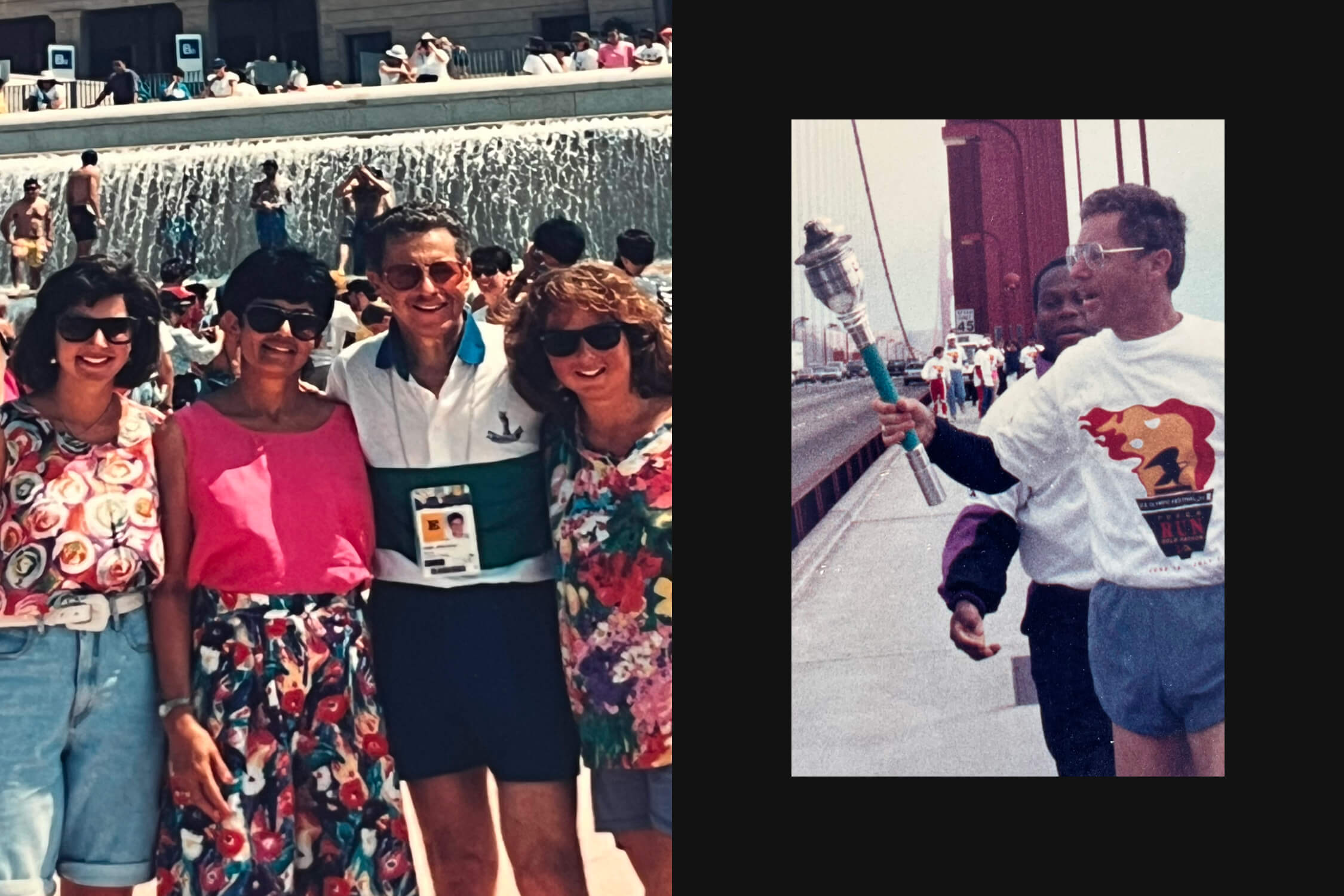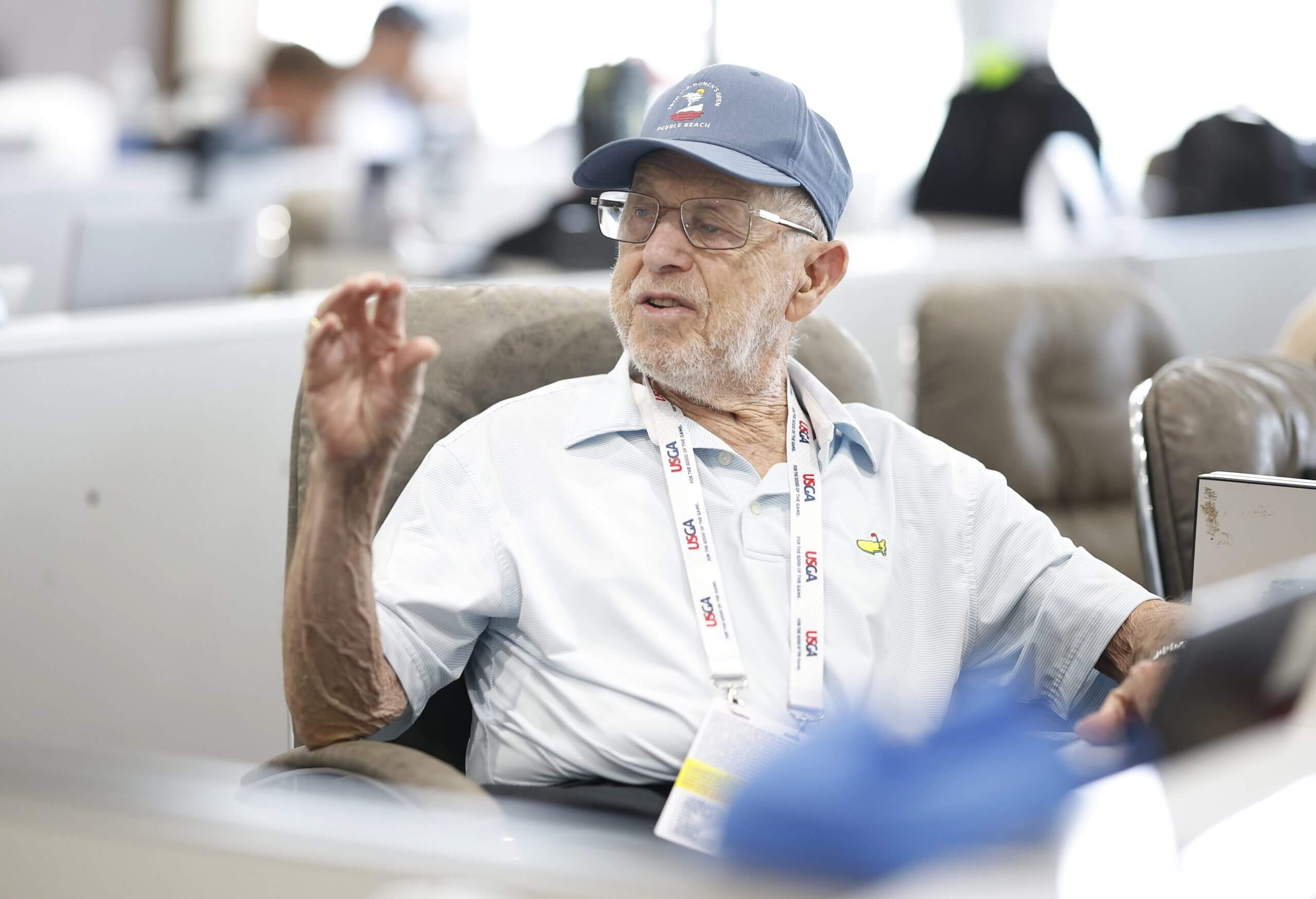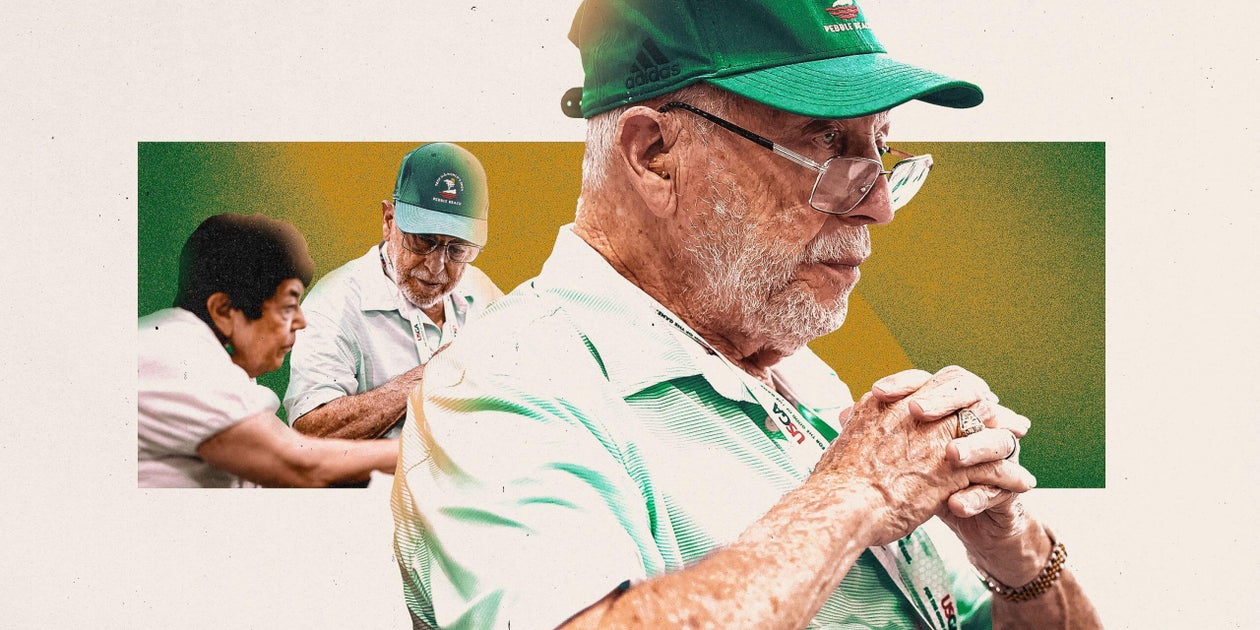When it’s time for the column, Art Spander squints his right eye hard, seeing what’s left to see.
It’s approaching early evening on a Thursday afternoon of the 2025 U.S. Open, the 183rd major golf tournament of his career. The first? Well, that was 1966. A sidebar for the San Francisco Examiner. But that was a long time ago. Art is thinking about today.
Maybe something on Brooks Koepka, going for a sixth career major win. “But that’s a long way off.” Maybe Rory McIlroy. “But he shot 74 and didn’t talk today.” Maybe little-known J.J. Spaun, the first-round leader. “He’s interesting.”
“You know, I’m a columnist,” he explains to someone half his age, but still pretty old. “I’m looking for angles.”
So Art Spander, 86, one of the last of his kind, a big name of another era, gets to work.
A lifetime of this. Games, tournaments. All of them. Everywhere. In the smallest rink on the biggest day, when a bunch of American boys beat a big red army in the Adirondack Mountains as Al Michaels yelled about miracles. In Cincinnati for Henry Aaron’s 714th homer, and in Atlanta five nights later for No. 715. Joe Montana to Dwight Clark. Johnny Miller’s 63. Kirk Gibson limping ’round the bases, pumping his arm. (“I thought, oh, those poor Athletics.“) The highs and lows of Tiger. Federer in his prime. The fall of OJ. (“Boy, was I wrong about him.”) All told, he put pen to pad at over 60 Rose Bowls, over 50 Masters, over 40 Super Bowls, over 30 Finals Fours, nearly 20 World Series and a few Olympic Games.
Blinded in the left eye at age 8, thanks to a “a roundhouse” when roughhousing with some kids, Art saw it all through one good eye. Nowadays, he hardly has that.
The topic has been narrowed down — Spaun. “I know he’s played well the last few months,” Art says. “Boy, he’d be a great story.”
So begins another column.
This is what’s left when all the lines of life are blurred. When what one does becomes who one is. When one can’t stop being who one is because one doesn’t know who else to be. When one’s time on this blue marble turns into living history.
And when, under it all, there’s the kind of love you write stories about.
The cursor is blinking. Art starts talking. Liz Spander starts typing.
Eons ago, back when people licked their thumbs and peeled giant pages of broadsheet from right to left, press boxes and media centers were packed with sportswriters from all over, pressing keys and pounding copy. Everyone knew everyone. They sprang up like circus tents. One city, one day. Another, the next. Expense accounts were flush. Columnists were kings.
Today, a new world. As many people work for the teams and leagues as they do for outlets and institutions. There are social media stars being social and influencers influencing. Video folks. Podcast folks. Gambling folks. Times have changed and these rooms reflect it — a codified world of brands and content and bite-sized news.
Then Art walks in. The thump of a cane, an uneasy step forward. He’s down to 8-to-10 percent vision in that right eye. Glaucoma. He struggles badly with his balance. Liz guides Art in, holding out one arm and dragging a roller bag with the other. She is a much younger 84. The two married in 1962.
Even at a golf tournament, easily the crustiest of media centers, you will find that Art is old. There’s a certain disbelief as he arrives. How is he still doing this? Why is he still doing this? Should he still be doing this?
“The first thing I think anytime I see Art is, Liz is a saint,” says John Hopkins, 80, formerly the longtime golf correspondent for The Times, now semi-retired. “How many wives would do all this for their husband? I’ve had two who wouldn’t do it for me.”
It’s the job. It’s the life. It’s who Art is. Liz knows it. Debbie, their older daughter, knows it. Wendy, their younger daughter, knows it.

Spander, right, awards Tiger Woods the GWAA player of the year trophy before the 2006 Masters. (David Cannon / Getty Images)
Roger Kahn, the author, once wrote, “Sports tells anyone who watches intelligently about the time in which we live.” This, down to the marrow, is how Art has encountered the world. The players, the people, the relationships. The games, the questions, the stories. The other writers. The travel. Art has written so much, about so many things, for so long, that it can be difficult to imagine him being young.
An anthology of Art’s collected writing was printed in 1989 — 36 years ago. Al Michaels wrote the foreword. The two met in 1973, when Art got wind that the young Cincinnati Reds broadcaster was coming to San Francisco as the Giants’ new play-by-play voice. The two were fast friends. As were their wives. All this time later, Michaels, 80, shrugs when he hears that Art has arrived in Pittsburgh to cover a U.S. Open that he will not actually see. Of course he is.
“No one has ever been as romantic about sports as Art,” Michaels says. “He works. He works hard. He cares. He cares hard. I don’t know how, but no matter what, he’s never lost that sense of wonder.”
Makes you think.
How much of that is left out there?
“I try not to talk so much anymore, but I still do,” says Art, after a lifetime being told he talks too much. “It’s just my makeup. I’m paranoid or whatever you call it. But what can I do about that? There are all these things I’ve seen.”
That picture book, the one in Art’s mind, it begins in 1960, fresh out of UCLA, a job as a copy boy and chauffeur for United Press International.
Then a job at the Santa Monica Evening Outlook (“We called it the Evening Outrage, but anyway …”). It was 1963. A gig covering the L.A. Rams and Dodgers. Roman Gabriel and Sandy Koufax. Big-time stuff.
Then the San Francisco Chronicle in 1965. Art found golf. Golf found Art. He covered his first Masters in 1967 (“Gay Brewer won.”), splitting a room at the Alamo Hotel in Augusta with a young writer named Dave Kindred.
Then the dream job. Lead sports columnist for the San Francisco Examiner in 1979. Art among the kings. Then a move to the Oakland Tribune in 1996. On the side, a regular column in the Sporting News that made him a national name and dispatches on American sports for the London Daily Telegraph. He was a regular on television and radio in the Bay Area.
“OK, Art,” I say, “but I asked about your wedding day.”
“Oh, right, sorry. I digressed.”
If, on a certain June day in 1962, you were driving up the 101 along the California coast and happened to see the two happiest faces there’s ever been, that was Art and Liz Spander. The honeymoon was in Vancouver. They stopped at the Seattle World’s Fair on the way. They’ve been traveling ever since. Golf tournaments. Super Bowls. Final Fours. Who could’ve ever imagined?
Debbie was firstborn Then came Wendy. Immediately, they were along for the ride. The girls swam in Palm Springs swimming pools with Jack Nicklaus’ kids. They played with Rick Barry’s fleet of sons on the court at Oakland Arena. They curled up in sleeping bags in the nook under the stairs of a crowded house of sportswriters covering the 1988 Summer Olympics in Seoul, South Korea.
“It was all very normal,” Wendy says.
Only later did the girls come to realize Reggie Jackson didn’t sit at other families’ dinner tables. Their dad was larger than life, and their world was subscribed to his schedule.
“He was gone a lot, but the things he exposed us to were amazing,” Debbie says.

Sports writing took Spander and his family everywhere, even giving him the chance to carry the 1988 Olympic torch. (Courtesy Spander family)
As it goes when one gets older, Wendy and Debbie grew up to understand that while, yes, it was dad who everyone fawned over, it was their mother who made the movie. Liz taught Spanish at the girls’ elementary school. She dropped them at practices and sat in the stands for games. She paid the bills and handled the books. She joined a travel agency in 1973 and began a career that would, in time, support Art’s adventures. She started a women’s travel group to go to places her husband had no interest. Passport stamps from India, China, Vietnam, Myanmar, Israel, Morocco and Bhutan.
Products of their generation. Art gave everything he had to the job because there was someone else giving theirs to everything else. Liz did what she needed to do.
“She kept the house running, worked full-time and basically raised us,” Wendy says. “I think, maybe in third grade or so, my dad tried to coach a softball team at my school. It was a disaster. All these girls running in all different directions. He was like, well, I’m never doing this again.”
She laughs a good laugh.
“That’s just the way it was,” Wendy says. “It still is. She did everything and still does everything.”
Even the writing.
Art can make out some giant-sized words, and sort of make out what’s happening on the leaderboard, but he can’t make much sense of what’s in front of him, hasn’t for most of the last year or two. His vision is fading like a ship in the fog. He gets frustrated, embarrassed, upset. But Liz is here, beside him, both at home on the road, with her fingers on the keys.
These columns are posted to Art’s personal website. Not a lot of places out there for an 86-year-old to be published nowadays, ya know? Sure, there aren’t many readers. But that’s not why they do it.
In a world of clickable headlines and ragebait, everything about Art’s work, and his world, amounts to a continuation of his time. He has every Sports Illustrated ever printed and stacks upon stacks upon stacks of newspapers in his basement. In his mind, the writer is history’s curator and cynicism doesn’t pass for wisdom. He doesn’t know any other way.
“This,” Liz says, “is his identity.”
So Art dictates. Liz types.
“Slow down,” she says.
“Sorry, sorry,” Art replies.
Another column filed.
Art used to theorize with the Washington Post’s Chuck Culpepper that hopscotching from sporting event to sporting event can be some kind of secret tonic. “That there’s something about being with the youth,” says Culpepper, 63, “that keeps you young.”
Another theory: Maybe it’s more than that. Maybe it’s the sense of place. And the story yet to be told. And the adventures, and characters, and relationships. Maybe it’s doing the one weird thing you were meant to do. Maybe it’s the journey.
Art was one of the first writers to travel with a computer. The Teleram P-1800. An enormous thing weighing nearly 20 pounds and resembling a blue suitcase. He would ship it from one game to another or put it on a luggage rack and pull it through the airport.
That was back in the late ’70s, into the ’80s. Art began his career by “stupidly” trying to write like Jim Murray, the LA Times demigod. He later found his voice and wrote the kind of columns that winked at you. He wrote of “the calculated gamble that passes for Al Davis’s life.” He interviewed a 72-year-old Joe DiMaggio at a funeral home an hour before Joe was to serve as a pallbearer in a friend’s funeral. He played the first golf course to open in China since it fell under communist rule in 1949. He wrote about a thoroughbred named Cassaleria that was also blind in one eye. They had a lot in common. “We spend more time drifting right than Ronald Reagan.”
Everywhere Art went, his files went. A stack of papers, anywhere from 1-to-2 feet high. It’s what everyone remembers the most from those days. Not because the clips were meticulously sorted, but because they were open to all. Culpepper, as a Lexington Herald-Leader columnist in 1998, asked Art about Cal-Stanford and “The band is on the field!” Art, of course, was there that day, but he had more than memories. He handed Chuck a stack of clips from a game played 16 years earlier.
“I think I realized then just how big his heart is,” Culpepper says.
The stories of Art’s accumulation of information go on and on. Kindred, maybe the best sportswriter of that generation, says he was “the internet before the internet.” Even on deadline, he’d pull out a file for a fellow writer.
“I don’t think it ever registered with Art that we were competitors,” says Scott Ostler, 77, a columnist for the San Francisco Chronicle since 1991. “He didn’t give a s— about beating anybody else or scooping people. He just wanted to write what he wanted to write.”
Today, Art’s computer is a dusty ThinkPad with a smudged screen; marks made pointing at what he wants to read. From that first computer to this one, there’s a story of a gift few ever find. Unending curiosity. Art says he wishes he were 30 years younger, so he could see how the stories of today shape tomorrow. He talks about the stories he’d write, wiggling his fingers, pressing down keys that aren’t there.
How is he still doing this? Why is he still doing this?
“When he grew up, he wanted to be who he became,” says Kindred, 84, “When you’ve done that, you want to hold onto it.”
It’s late in the week at Oakmont and Art Spander is over at his desk, mulling what to write. Liz is over here chatting, thinking about the future. Let it be known, we should all be so fortunate to have seen and done what Art and Liz have seen and done. No one, though, should ever have to decide between who they are and what they’re able to do.
Wendy and Debbie talk about this often.
It’s unfair to Mom to ferry Dad from place to place. The physical toll. Seriously, what happens if something goes wrong? Art nearly took a spill down the stairs in the Augusta National press building two Aprils ago, but was caught by another writer before hitting the steps. He wisely opted not to tell the family about that. “It’s really demanding on her,” Wendy says of her mom. “It’s hard as a daughter to see.”
But what about Dad? Is it fair to be held back from his second home, from all the names he knows, from the place he’s most himself? Memories of the pandemic shutdown aren’t too far in the distance. “I remember seeing him wilt,” Debbie says. “He didn’t know what to do.” The girls hoped he would finally sit down and write a book, but that never happened. At this point, even if he could, he’d never do so about himself. Liz says he was always oblivious, or embarrassed, of his fame.
There’s no right answer, but there is an obvious reality. This year’s U.S. Open? This is probably it. The final major event he will cover.
“The last one,” Liz says, tapping fingernails atop a table. “He knows that, I think. His eye really seems to have gotten worse. Even just this week. Glaucoma is just taking over. It’s a shame. He loves to read. He loves to write. He can’t do either.”

He’s covered 183 major golf tournaments in his career, starting in 1966. (Cliff Hawkins / Getty Images)
At least he’s done so much already. Both daughters? They embarked on careers in sports. Debbie is a big-time agent representing players and high-profile media types. After graduating from Stanford, she dabbled in sportswriting before going to law school. Wendy worked for years at EA Sports, handling PR for the “Madden” football empire and the “Tiger Woods PGA Tour” series before moving to a tech communications job. As a student at Penn, she wrote for the school paper and penned a column on how her dad’s career influenced all her decisions.
Art was — is — a man of eclectic tastes. A collector of Native American Kachina dolls. The theatre. Shakespeare. Running, so much so that he carried the Olympic torch through San Francisco in the Summer of 1988. Wine, so much so that the Spanders have about 800 bottles in their basement.
But most of all, there’s Liz. And, in all of this, the only story that really matters is still going.
“I’m here and I’m very fortunate,” Art tells me, “because she allows me to be.”
You can see it as they leave. Feeling the ground under him change, Art steadies his cane and takes hold of Liz. He doesn’t let go. Pushing one foot forward, he feels the ramp of the media center turn into the grass of the golf course. Art lets out a laugh and offers assurance. “I got it, I got it.”
They stop together, for a moment.
“OK,” Art says, “I just need to know what’s coming next.”
(Illustration: Kelsea Petersen / The Athletic; photos: Cliff Hawkins / Getty Images)
